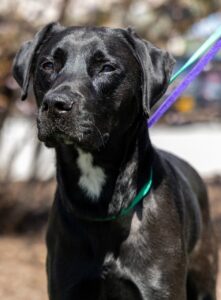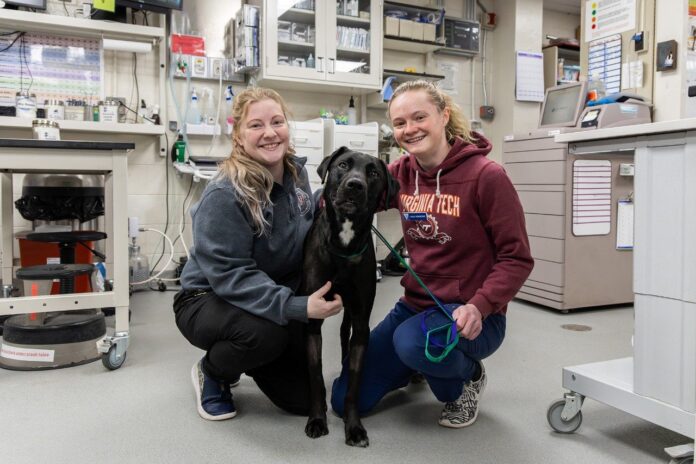For April and Brian Barlow, letting their dogs out to enjoy some outdoor time on their property in Princeton, West Virginia, is just part of their morning routine. March 13 began like any other day. But Chop, their curious Labrador retriever mix, would follow his nose into trouble.
Through attentive veterinary care and an emergency referral to the Virginia-Maryland College of Veterinary Medicine’s Veterinary Teaching Hospital, Chop recovered from neurological intoxication.
About an hour after letting Chop outside, the Barlows looked outside to find the dog standing on the porch, shaking uncontrollably. They immediately brought Chop to their local veterinarian, Michelle Postle at Happy Tails Veterinary Clinic. Chop’s tremors soon progressed to seizures, and he was vomiting violently. When Postle administered antiseizure medication, it wore off in the span of a minute.
Chop was in dire straits. Postle called the Veterinary Teaching Hospital. Veterinary neurologists advised her on doses and medication. Multiple teams worked tirelessly to help Chop beat the odds.
“Not only was it interdepartmental collaboration, but it was collaboration with the veterinary community. If it was not for their vet calling us, there is no question the dog wouldn’t have made it. What she started with taking initiative with stabilization is very much why he is alive today,” said neurology/neurosurgery resident Leanne Jankelunas.
Chop needed intensive treatment at the Veterinary Teaching Hospital, but there are no pet ambulances, so the job fell to Chop’s family. The challenge? Chop needed near constant medication to keep the seizures at bay.
While Brian Barlow drove, he had one phone giving him directions to the Veterinary Teaching Hospital and another phone set with a timer. Every 30 seconds, the timer went off and April Barlow gave Chop a dose of anesthetic through an IV.
The family drove like this for an hour and a half until they finally reached the Veterinary Teaching Hospital.

Before Chop arrived, the neurology and critical care teams met to come up with a plan to address the seizures, potential brain swelling, and the medications Chop would need to pull through.
“The moment he arrived, he was a combination of anesthetized and comatose,” said Laura Vega, clinical assistant professor of emergency and critical care medicine. “It was all hands on deck. It was fantastic to see multiple services coming together to get everything done so quickly.”
Chop was in respiratory distress and needed to be intubated. He received medication to decrease brain swelling and an anticonvulsive. He was given a muscle relaxant to try to control his tremors, and he also needed to get his blood sugar up.
At the time, nobody knew exactly what Chop had ingested.
“It was minute-to-minute, hour-to-hour. In many toxicity cases, you’re a little bit in the blind. There’s no specific antidote you’re going for — you’re just trying to keep them alive and roll with the punches,” said Vega.
In addition to activated charcoal to absorb toxins, Chop was given intralipid therapy, a fat emulsion given intravenously to draw the toxins from tissues into the blood, where it can be more easily eliminated.
“It takes a village. I am really happy to have the ICU technical staff that I have — we were working together through the night. They really kept him alive and we worked so, so hard. It was a huge effort,” said Vega.
In addition to the toxin itself, Chop was in respiratory distress. Aspirating his own vomit caused severe infection and inflammation in his lungs, but Chop recovered.
Later testing confirmed that Chop had consumed tremorgenic mycotoxins, which grow on things like moldy food and compost piles.
“It turns out that he’s a little miracle kid,” said Vega. “Neurologically, he was almost back to normal within 24 hours.”
Though he still had trouble breathing, the next day the Barlows saw Chop on his feet with no tremors or seizures. His appetite and energy slowly returned, and now, Chop is back to his old self.
“We never dreamed we would be picking him up like this,” said April Barlow. “If it wasn’t for your team and Dr. Postle’s team, our baby wouldn’t be coming home with us.”

